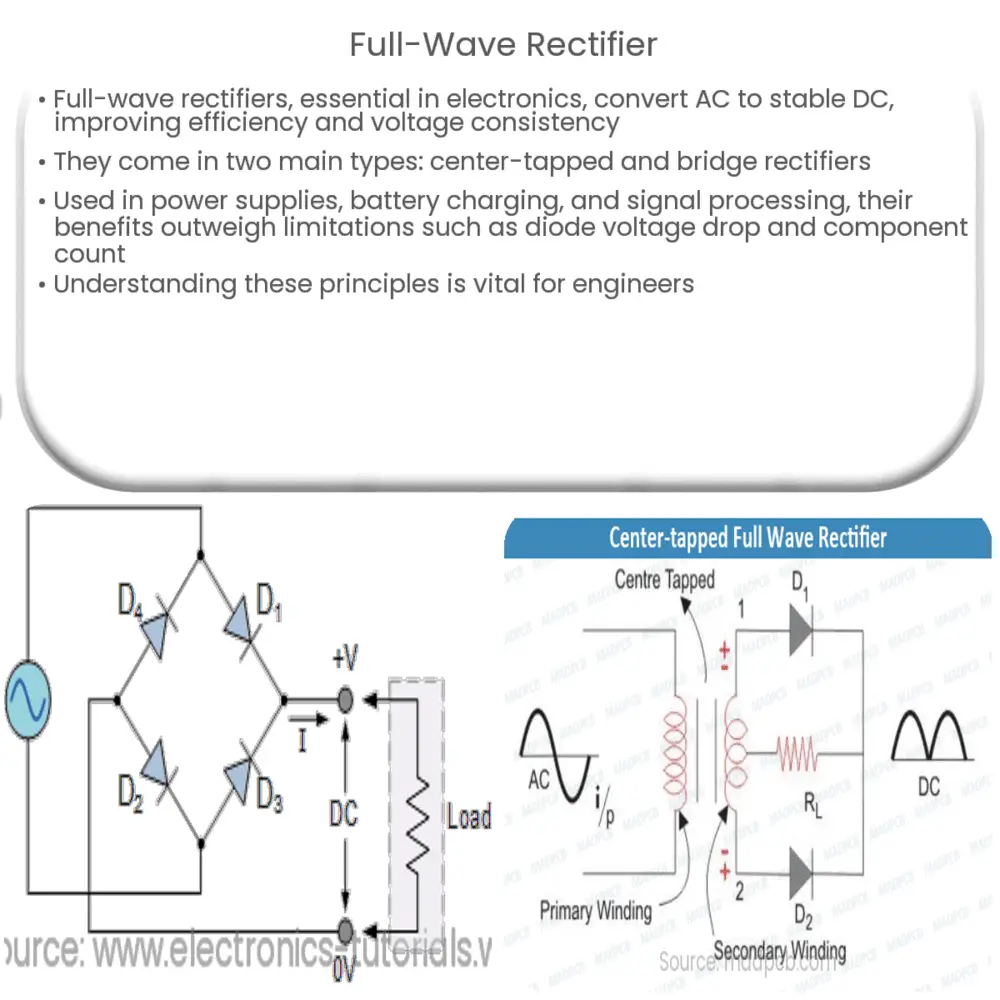A full-wave rectifier is an electronic component that converts alternating current (AC) into direct current (DC), enabling efficient and stable power supply.

Full-Wave Rectifier: An Overview
A full-wave rectifier is an essential component in electronics and electrical engineering, responsible for converting alternating current (AC) into direct current (DC). This conversion is crucial in many applications, as DC voltage is more stable and less fluctuating compared to AC voltage, making it easier to handle and utilize in electronic circuits. In this article, we will explore the fundamentals of full-wave rectifiers, their working principles, and their applications.
Introduction to Full-Wave Rectifiers
There are two primary types of rectifiers: half-wave rectifiers and full-wave rectifiers. Half-wave rectifiers allow only one half of the AC waveform to pass through, while full-wave rectifiers permit both halves to pass. The full-wave rectifier’s ability to utilize both halves of the AC waveform results in a higher efficiency, lower voltage ripple, and a more consistent DC output voltage.
Working Principle of Full-Wave Rectifiers
The full-wave rectifier utilizes diodes, which are semiconductor devices that allow current to flow in one direction only. The arrangement of diodes in a full-wave rectifier is such that they enable the conversion of both the positive and negative half-cycles of the AC waveform into a pulsating DC output. There are two main types of full-wave rectifiers: the center-tapped full-wave rectifier and the bridge rectifier.
Center-Tapped Full-Wave Rectifier
A center-tapped full-wave rectifier uses a center-tapped transformer and two diodes. The center tap divides the transformer’s secondary winding into two equal halves, which allows the diodes to conduct during both positive and negative half-cycles of the input AC waveform. During the positive half-cycle, one diode conducts, and during the negative half-cycle, the other diode conducts. The result is a pulsating DC output that includes both half-cycles of the input AC waveform.
Bridge Rectifier
A bridge rectifier consists of four diodes arranged in a bridge configuration. Unlike the center-tapped full-wave rectifier, a bridge rectifier does not require a center-tapped transformer. The diodes in a bridge rectifier are connected in such a way that two diodes conduct during the positive half-cycle and the other two during the negative half-cycle. This configuration results in a pulsating DC output, with both half-cycles of the input AC waveform combined.
Applications of Full-Wave Rectifiers
Full-wave rectifiers find a wide range of applications in various electronic and electrical systems. Some of the most common applications include:
- Power supplies: Full-wave rectifiers are used in power supplies to convert AC voltage to a stable DC voltage, which is then used to power electronic devices and circuits.
- Battery charging: Full-wave rectifiers are utilized in battery chargers to convert AC voltage to DC voltage required for charging batteries.
- Signal processing: Full-wave rectifiers are employed in signal processing circuits for detecting the amplitude of an AC signal or demodulating amplitude-modulated (AM) signals.
Advantages of Full-Wave Rectifiers
Compared to half-wave rectifiers, full-wave rectifiers offer several advantages, making them the preferred choice for many applications. Some of these advantages include:
- Higher efficiency: Full-wave rectifiers utilize both half-cycles of the AC waveform, resulting in a more efficient conversion of AC to DC.
- Lower voltage ripple: The output of a full-wave rectifier has a lower voltage ripple, making it smoother and more stable than that of a half-wave rectifier.
- Reduced transformer size: Full-wave rectifiers require smaller transformers compared to half-wave rectifiers, as they use both half-cycles of the AC waveform, leading to a more compact and cost-effective design.
- Reduced harmonics: Full-wave rectifiers generate fewer harmonics in the output waveform, which can help minimize interference in electronic circuits.
Limitations of Full-Wave Rectifiers
Despite their numerous advantages, full-wave rectifiers have some limitations that need to be considered in specific applications:
- Diode voltage drop: Diodes used in full-wave rectifiers have a voltage drop across them, which can result in some power loss and reduced efficiency.
- Higher component count: Full-wave rectifiers, particularly bridge rectifiers, require more diodes than half-wave rectifiers, which can lead to increased complexity and cost.
- Transformer requirement: Center-tapped full-wave rectifiers necessitate the use of center-tapped transformers, which can be more expensive and less readily available than standard transformers.
Conclusion
Full-wave rectifiers play a crucial role in converting AC voltage to stable DC voltage for various electronic and electrical applications. Their ability to utilize both half-cycles of the AC waveform results in higher efficiency, lower voltage ripple, and a more consistent DC output voltage. Although full-wave rectifiers have some limitations, such as diode voltage drop and increased component count, their numerous advantages make them an essential component in power supplies, battery charging systems, and signal processing circuits.
Understanding the principles and applications of full-wave rectifiers is essential for anyone working in electronics or electrical engineering. By selecting the appropriate type of full-wave rectifier and considering its advantages and limitations, engineers can design efficient and reliable electronic systems that meet the needs of various applications.

